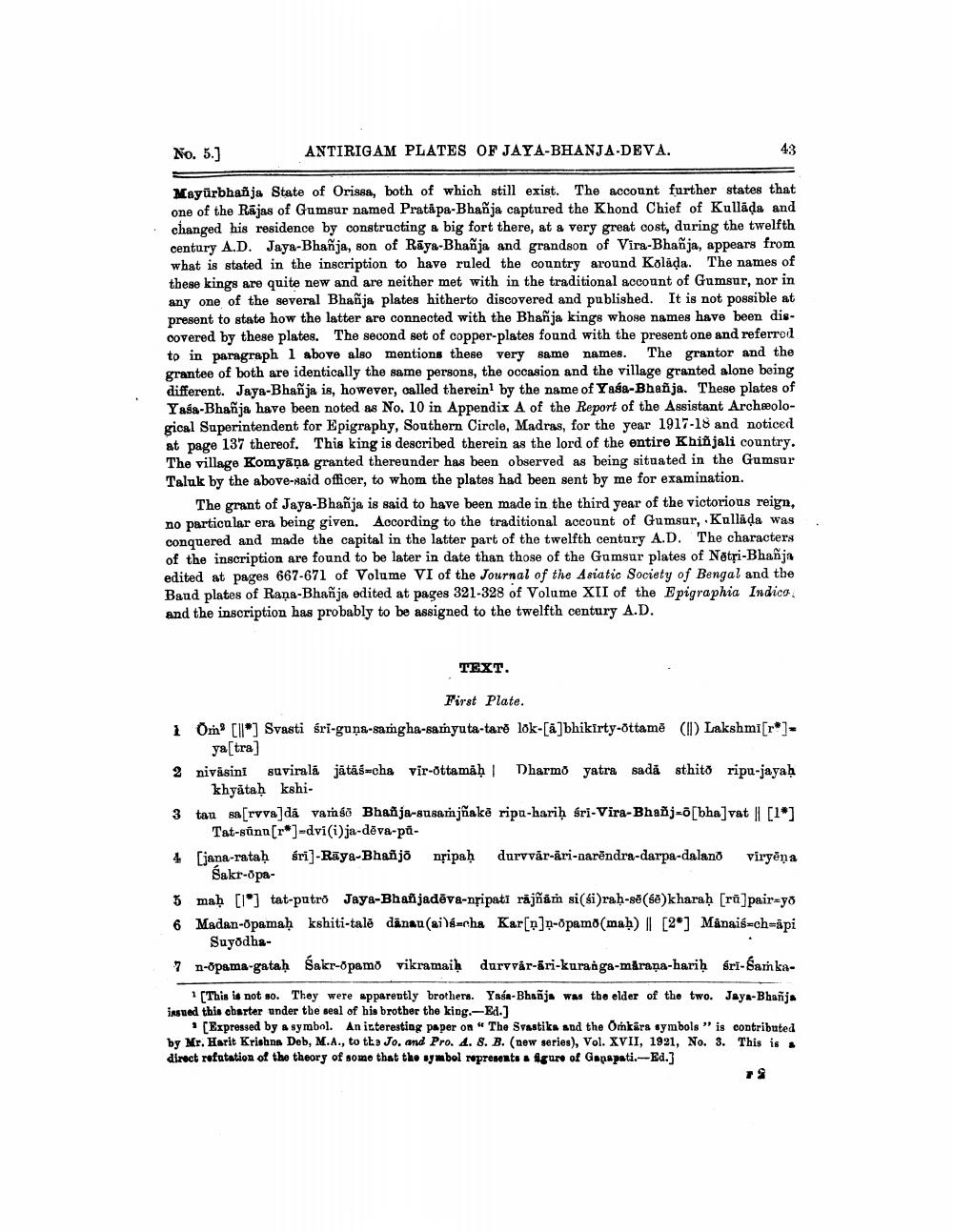________________
No. 5.)
ANTIRIGAM PLATES OF JAYA-BHANJA-DEVA.
Mayürbhanja State of Orissa, both of which still exist. The account further states that one of the Rājas of Gumsur named Pratåpa-Bhañja captured the Khond Chief of Kullada and changed his residence by constructing a big fort there, at a very great cost, during the twelfth century A.D. Jaya-Bhañja, son of Rāya-Bhañja and grandson of Vira-Bhañja, appears from what is stated in the inscription to have ruled the country around Koláda. The names of these kings are quite new and are neither met with in the traditional account of Gumsur, nor in any one of the several Bhanja plates hitherto discovered and published. It is not possible at present to state how the latter are connected with the Bhañja kings whose names have been discovered by these plates. The second set of copper-plates found with the present one and referred to in paragraph 1 above also mentions these very same names. The grantor and the grantee of both are identically the same persons, the occasion and the village granted alone being different. Jaya-Bhañja is, however, oalled therein! by the name of Yasa-Bhaja. These plates of Yasa-Bhañja have been noted as No. 10 in Appendix A of the Report of the Assistant Archæological Superintendent for Epigraphy, Southern Circle, Madras, for the year 1917-18 and noticed at page 137 thereof. This king is described therein as the lord of the entire Khiñjali country. The village Komyāņa granted thereunder has been observed as being situated in the Gumsur Taluk by the above-raid officer, to whom the plates had been sent by me for examination.
The grant of Jaya-Bhañja is said to have been made in the third year of the victorious reign, no particular era being given. According to the traditional account of Gumsur, Kullāda was conquered and made the capital in the latter part of the twelfth century A.D. The characters of the inscription are found to be later in date than those of the Gumsur plates of Natri-Bhañja edited at pages 667-671 of Volume VI of the Journal of the Asiatic Society of Bengal and the Baud plates of Raņa-Bhañja edited at pages 321-328 of Volume XII of the Epigraphia Indico and the inscription has probably to be assigned to the twelfth century A.D.
TEXT.
First Plate. i Om [ll] Svasti sri-guna-samgha-samyuta-tard lok-[X]bhikirty-öttamē (1) Lakshmi[r]=
ya tra] 2 nivāsini suviralā jātāš-cha vir-Ottamāḥ| Dharmo yatra sadá sthito ripu-jayaḥ
khyātaḥ kshi3 tau sa[rvva]dä vars Bhañja-susamjñakë ripu-hariḥ sri-Vira-Bhañj-7[bha]vat || [1]
Tat-sünn[r*]-dvi(i)ja-dova-på4 fiana-ratah sri)-Ritya-Bhanjo mripah durvvår-ari-narendra-darpa-daland viryena
Sakr-opa5 maḥ [18] tat-putro Jaya-Bhañjadēva-nripati rājñām si(fi)rah-se (68)khara) [rū]pair=yð 6 Madan-Opamaḥ kshiti-tale dänau(ails=rha Kar[o]p-opamð(mah) || [2"] Månais-ch-api
Suyodha7 n-opama-gataḥ Sakr-Opamo vikramai) durvvår-äri-kuranga-máraņa-hari) sri-Samka
(This is not so. They were apparently brothers. Yasa-Bhañja was the elder of the two. Jaya-Bhañjs insued this charter under the seal of his brother the king.-Ed.]
1 [Expressed by a symbol. An interesting paper on "The Svastiks and the Omkars symbols" is contributed by Mr. Harit Krishna Deb, M.A., to th) Jo, and Pro. 4. 8. B. (new series), Vol. XVII, 1921, No. 3. This is . direct refutation of the theory of some that the symbol represents a figure of Gapapati.-Ed.]




